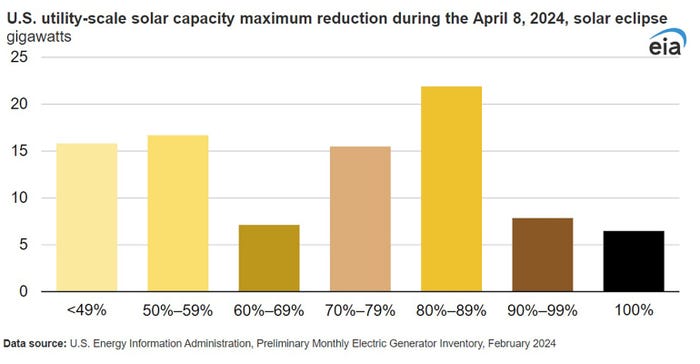The Crucial Role of Battery Storage During Solar Eclipses
Discover how battery storage is crucial in maintaining grid stability during solar eclipses, ensuring resilience and efficient energy distribution.

Battery storage plays a crucial role in the resilience and efficiency of electric generation systems, particularly during events like solar eclipses. During the April 8 solar eclipse, the sunlight across a vast region of the United States will be temporarily obstructed. This eclipse underscores the importance of battery storage in mitigating the impact of such events on the electricity grid.
The impact of solar eclipses on electricity grids
Solar-powered generators, particularly those in the path of totality, will experience the most pronounced effects, with the moon blocking direct sunlight for several minutes. Even areas around the partial eclipse path will witness diminished solar generation for a couple of hours. Consequently, utilities must prepare for the lost solar energy by increasing output from other sources of electricity generation to supplement the decrease in solar power.
According to the U.S. Energy Information Administration (EIA), the eclipse will affect utility-scale solar generation facilities with a combined capacity of 6.5 gigawatts (GW) and partially block sunlight to facilities totaling 84.8 GW capacity. “A full solar eclipse will briefly but fully obscure sunlight to utility-scale solar generation facilities from Texas through Maine with a combined 6.5 gigawatts (GW) capacity. In addition, the eclipse will partially block sunlight to facilities with a combined 84.8 GW of capacity in an even larger swath of the United States around peak solar generating time.”
The eclipse presents a dual challenge to electricity grids. Firstly, utility-scale solar generation will experience lower output along the eclipse's path, requiring the dispatch of alternative generating resources. Moreover, homes and businesses with small-scale solar systems will require additional electricity from the grid, further stressing the system. This increased demand, particularly from small-scale solar, underscores the need for effective grid management strategies.
The role of battery storage in grid resilience
Battery storage emerges as a critical component of the grid's response to the eclipse. Battery storage systems help balance the electricity system by absorbing excess solar or wind generation when demand is low and discharging it when demand is high. EIA explained that compared to the 2017 solar eclipse, the US now boasts significantly higher battery storage capacity, with 15.4 GW available to support grid operations. IEA claims that during the last solar eclipse in 2017, only 0.6 GW of battery storage was operating in the US.

Even with the eclipse, EIA still expects solar generation to be the third-largest contributor of electricity in the United States on April 8, behind natural gas and nuclear.Source: U.S. Energy Information Administration (Oct 2008).
Texas, with a substantial portion of its territory in the path of the eclipse, stands to lose the most solar generating capacity. At the same time, states like California and Florida face significant impacts due to their reliance on solar energy. However, the growth of solar electricity capacity in the US since 2017 has been remarkable, with Texas experiencing rapid expansion. Solar power has contributed to midday generation, especially in California and Texas.
The evolving landscape of the US electricity portfolio underscores the importance of battery storage in enhancing grid resilience and flexibility. Since the 2017 eclipse, nearly 100 GW of utility-scale and small-scale solar capacity has been added to the system, elevating solar generation to the third-largest contributor of electricity in the US, behind natural gas and nuclear power.
Battery storage plays a vital role in ensuring the reliability and stability of electric generation systems, particularly during events like solar eclipses. As solar energy continues to proliferate, investment in battery storage infrastructure will be essential to effectively manage fluctuations in solar generation and maintain grid stability. The remarkable surge in US battery storage capacity is poised to witness an 89% increase by the end of 2024. By leveraging battery storage technologies, utilities can mitigate the impacts of solar eclipses and other weather-related challenges, paving the way for a more resilient and sustainable energy future.
About the Author(s)
You May Also Like





